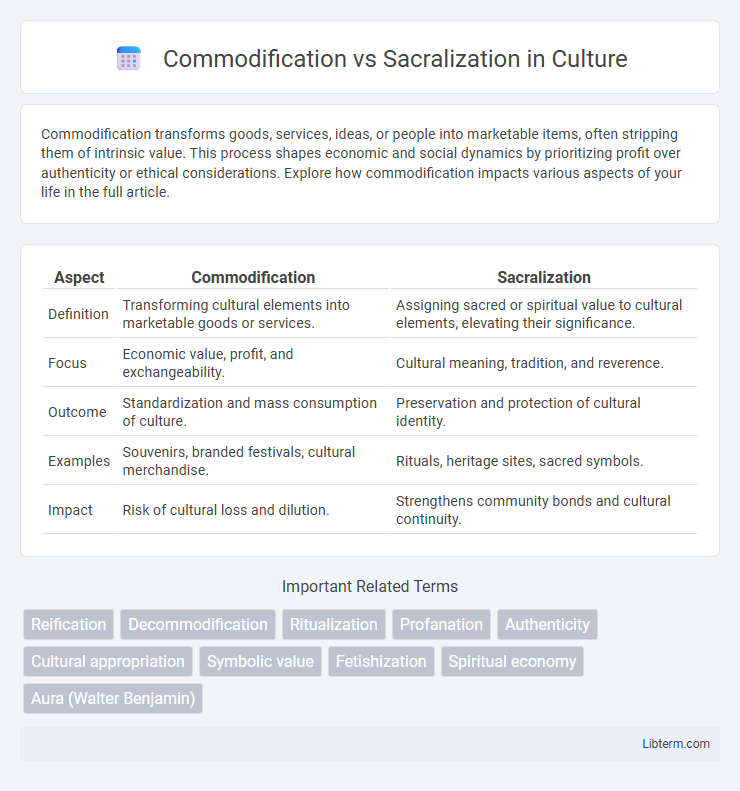Commodification transforms goods, services, ideas, or people into marketable items, often stripping them of intrinsic value. This process shapes economic and social dynamics by prioritizing profit over authenticity or ethical considerations. Explore how commodification impacts various aspects of your life in the full article.
Table of Comparison
| Aspect | Commodification | Sacralization |
|---|---|---|
| Definition | Transforming cultural elements into marketable goods or services. | Assigning sacred or spiritual value to cultural elements, elevating their significance. |
| Focus | Economic value, profit, and exchangeability. | Cultural meaning, tradition, and reverence. |
| Outcome | Standardization and mass consumption of culture. | Preservation and protection of cultural identity. |
| Examples | Souvenirs, branded festivals, cultural merchandise. | Rituals, heritage sites, sacred symbols. |
| Impact | Risk of cultural loss and dilution. | Strengthens community bonds and cultural continuity. |
Understanding Commodification: A Modern Perspective
Commodification refers to the process by which goods, services, ideas, or even people are transformed into commodities to be bought and sold in markets, reflecting a modern economic perspective driven by capitalism. This transformation often reduces unique or culturally significant items to mere market values, detaching them from their original social, cultural, or sacred contexts. Understanding commodification involves analyzing its implications for identity, authenticity, and social relations in contemporary consumer societies.
Defining Sacralization in Contemporary Culture
Sacralization in contemporary culture refers to the process by which objects, ideas, or practices gain sacred or revered status, often transforming ordinary elements into symbols imbued with deep meaning and social significance. This contrasts sharply with commodification, where cultural elements are reduced to marketable goods stripped of intrinsic value. Contemporary sacralization often manifests in rituals, memorials, or identity movements that resist commercial exploitation and emphasize authenticity, heritage, or moral importance.
Historical Roots of Commodification and Sacralization
The historical roots of commodification trace back to the emergence of market economies in ancient Mesopotamia, where goods and services began to be assigned monetary value and exchanged. In contrast, sacralization has origins in early religious and cultural practices, where certain objects, spaces, or rituals were imbued with sacred meaning and protected from commercial use. These divergent historical processes highlight how societies have balanced material exchange with spiritual or symbolic significance over time.
Key Differences Between Commodification and Sacralization
Commodification transforms cultural or social elements into marketable goods valued primarily for exchange and profit, emphasizing economic benefit and consumer demand. In contrast, sacralization attributes sacred or spiritual significance to objects, practices, or ideas, often fostering reverence, moral value, and cultural identity. The key difference lies in commodification's focus on commercial utility versus sacralization's emphasis on intrinsic, symbolic, or religious meaning.
The Role of Capitalism in Encouraging Commodification
Capitalism drives commodification by transforming goods, services, and even cultural symbols into marketable products aimed at profit maximization. This process often reduces the intrinsic, sacred, or symbolic value of objects and practices, prioritizing exchange value over ritualistic or spiritual significance. The capitalist emphasis on consumer demand and competition incentivizes continuous reproduction of commodities, accelerating the erosion of sacralization in society.
How Sacralization Shapes Social and Cultural Values
Sacralization transforms everyday objects, spaces, and rituals into symbols of profound cultural significance, reinforcing collective identity and shared beliefs within a community. This process embeds social values deeply into traditions, fostering respect, continuity, and a sense of belonging that commodification cannot replicate. By elevating the sacred, sacralization preserves cultural heritage and promotes ethical frameworks that guide social behavior and communal norms.
Case Studies: Commodification in Art, Religion, and Nature
Commodification in art manifests as the transformation of creative works into marketable products, often reducing cultural significance to monetary value, evident in the global art market's treatment of indigenous artifacts. In religion, commodification appears in the commercialization of spiritual practices and symbols, such as the sale of relics, pilgrimage packages, and faith-based merchandise, diminishing sacredness in favor of profit. Nature experiences commodification through ecosystem services and ecotourism, where natural resources are marketed, sometimes leading to exploitation rather than conservation, contrasting with sacralization that treats the environment as inherently valuable and worthy of preservation.
The Impact of Sacralization on Identity and Community
Sacralization transforms objects, symbols, or practices into sacred elements that reinforce collective identity and strengthen community bonds by fostering shared values and rituals. This process counters commodification, which reduces cultural elements to marketable goods, often eroding their deeper significance and communal ties. The impact of sacralization on identity is profound, as it cultivates a sense of belonging and continuity within communities by emphasizing spiritual meaning over commercial value.
Ethical Implications: Commodification vs Sacralization
Commodification reduces sacred values to marketable goods, leading to ethical concerns about disrespecting cultural and spiritual significance. Sacralization, by contrast, preserves the intrinsic meaning and reverence of objects, protecting them from exploitation and ensuring respectful engagement. Ethical implications highlight the tension between commercial interests and maintaining the integrity of cultural or religious symbols.
Future Trends: Balancing Commodification and Sacralization
Future trends in balancing commodification and sacralization emphasize the integration of cultural heritage preservation with sustainable commerce, ensuring that sacred elements retain their intrinsic value amid market pressures. Innovations in digital technology enable immersive experiences that respect sacralized content while driving economic growth through authentic storytelling and ethical branding. This equilibrium fosters community empowerment and cultural continuity, positioning sacralization as a vital counterbalance to unchecked commodification in global markets.
Commodification Infographic

 libterm.com
libterm.com